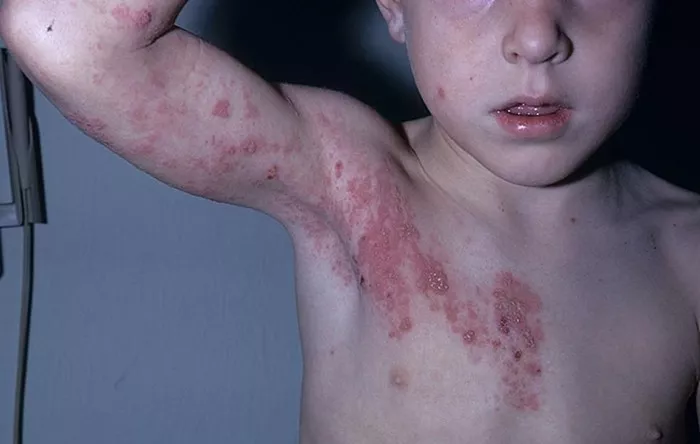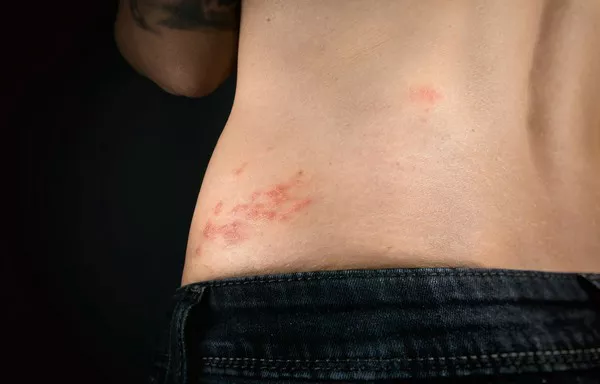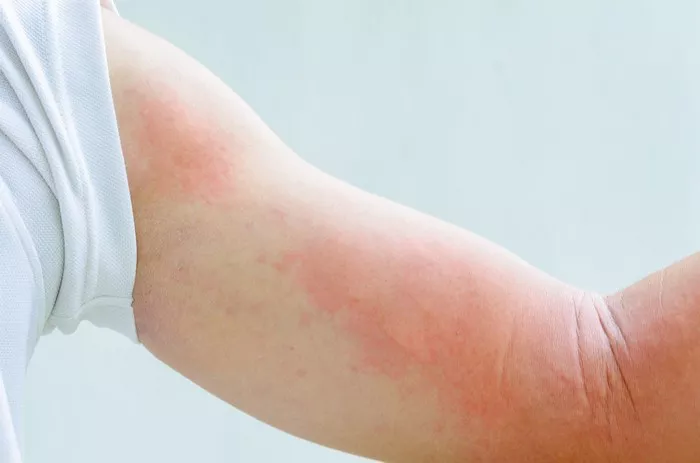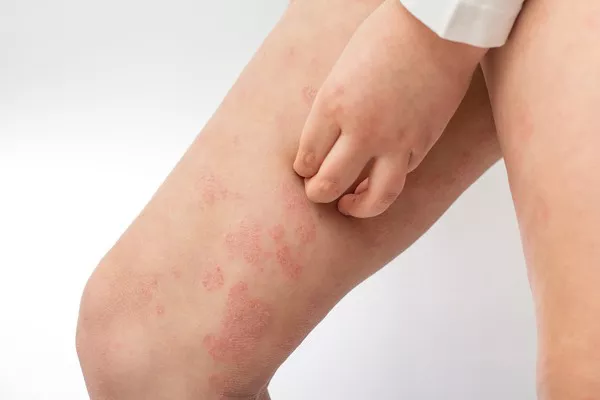Shingles, also known as herpes zoster, is a viral infection caused by the varicella-zoster virus, the same virus that causes chickenpox. After a person recovers from chickenpox, the virus remains dormant in the body’s nerve tissue and can reactivate years later, leading to shingles. This condition is characterized by a painful rash that usually appears on one side of the body, often in a band-like pattern. Understanding shingles, its symptoms, and the appropriate steps to take during a flare-up is crucial for effective management and relief.
Symptoms of Shingles
The symptoms of shingles typically develop in stages:
1. Early Symptoms: Before the rash appears, individuals may experience a range of symptoms such as headache, sensitivity to light, flu-like symptoms without a fever, and itching, tingling, or pain in a specific area where the rash will eventually develop.
2. Rash: The shingles rash usually begins as red patches that develop into fluid-filled blisters. These blisters may break open and crust over. The rash typically follows the path of a nerve and is most commonly found on the torso, but it can also occur on the face, neck, or other parts of the body.
3. Pain: Pain is a hallmark of shingles and can vary from mild to severe. Some people may experience intense pain without a significant rash. The pain can be burning, throbbing, or stabbing and is often described as excruciating.
4. Other Symptoms: In some cases, shingles can cause additional symptoms such as fever, chills, fatigue, and upset stomach.
Immediate Steps to Take During a Shingles Flare-Up
When a shingles flare-up occurs, prompt action can help alleviate symptoms and prevent complications. Here are the immediate steps to take:
1. Consult a Healthcare Provider
The first and most crucial step when experiencing a shingles flare-up is to consult a healthcare provider. Early diagnosis and treatment can significantly reduce the severity and duration of symptoms. Antiviral medications, such as acyclovir, valacyclovir, and famciclovir, are most effective when started within 72 hours of the rash appearing. These medications help to reduce pain, speed up healing, and lower the risk of complications.
2. Manage Pain
Pain management is a critical aspect of treating shingles. Over-the-counter pain relievers such as acetaminophen or ibuprofen can help reduce mild to moderate pain. For more severe pain, a healthcare provider may prescribe stronger pain medications, such as opioids or corticosteroids. Topical treatments, like lidocaine patches or creams, can also provide localized pain relief.
3. Protect the Rash
To prevent the spread of the virus and reduce the risk of secondary bacterial infections, it’s important to keep the rash clean and dry. Avoid scratching or picking at the blisters. Loose-fitting, cotton clothing can help minimize irritation. Applying calamine lotion or using cool, wet compresses can soothe itching and discomfort.
SEE ALSO: How Long Does the Burning Pain Last with Shingles
Long-Term Management of Shingles
While immediate treatment focuses on alleviating symptoms and preventing complications, long-term management is essential for individuals who experience recurrent flare-ups or have persistent pain after the rash has healed. Here are several strategies for long-term management:
1. Monitor for Postherpetic Neuralgia (PHN)
One of the most common complications of shingles is postherpetic neuralgia (PHN), a condition where the pain persists for months or even years after the rash has healed. Older adults are particularly susceptible to PHN. If you experience prolonged pain, consult your healthcare provider for appropriate treatment options. Medications such as gabapentin, pregabalin, or tricyclic antidepressants may be prescribed to manage PHN.
2. Maintain a Healthy Lifestyle
A healthy lifestyle can support your immune system and reduce the risk of future flare-ups. This includes eating a balanced diet, exercising regularly, getting adequate sleep, and managing stress. Chronic stress can weaken the immune system, making it more likely for the varicella-zoster virus to reactivate.
3. Consider Vaccination
The shingles vaccine is an effective way to prevent shingles and its complications. The CDC recommends the Shingrix vaccine for adults aged 50 and older, even if they have previously had shingles. Shingrix is administered in two doses and has been shown to be over 90% effective in preventing shingles and PHN.
Coping with the Emotional Impact
Dealing with shingles can be emotionally challenging due to the pain, discomfort, and potential for long-term complications. Here are some strategies to cope with the emotional impact:
1. Seek Support
Talking to friends, family, or joining a support group can provide emotional comfort and practical advice. Sharing experiences with others who understand what you’re going through can alleviate feelings of isolation.
2. Practice Stress-Reduction Techniques
Techniques such as meditation, yoga, deep breathing exercises, and mindfulness can help reduce stress and promote relaxation. These practices can be particularly beneficial in managing the chronic pain associated with shingles and PHN.
3. Consult a Mental Health Professional
If you’re struggling with anxiety, depression, or other emotional difficulties related to shingles, consider seeking help from a mental health professional. Therapy can provide strategies for coping with pain, managing stress, and improving your overall quality of life.
Alternative and Complementary Therapies
In addition to conventional treatments, some people find relief from shingles symptoms through alternative and complementary therapies. While these approaches may not be scientifically proven to cure shingles, they can be beneficial as part of a holistic treatment plan. Always consult your healthcare provider before starting any alternative therapies.
1. Acupuncture
Acupuncture involves inserting thin needles into specific points on the body to alleviate pain and promote healing. Some studies suggest that acupuncture may help reduce the pain and discomfort associated with shingles and PHN.
2. Herbal Remedies
Certain herbs and supplements are believed to boost the immune system and reduce inflammation. Examples include echinacea, elderberry, and turmeric. However, the effectiveness of these remedies can vary, and they should be used with caution, especially if you are taking other medications.
3. Essential Oils
Essential oils like lavender, chamomile, and tea tree oil have anti-inflammatory and soothing properties. Diluting these oils and applying them to the affected area can help alleviate itching and discomfort. However, it’s important to do a patch test first to ensure you do not have an allergic reaction.
Preventing Future Flare-Ups
While it’s not always possible to prevent shingles, certain measures can reduce the likelihood of future flare-ups:
1. Boost Your Immune System
A strong immune system can help keep the varicella-zoster virus in check. Maintain a healthy diet rich in fruits, vegetables, lean proteins, and whole grains. Consider taking vitamins and supplements, such as vitamin C, vitamin D, and zinc, to support immune function.
2. Manage Chronic Conditions
Chronic conditions like diabetes, HIV, or autoimmune diseases can weaken the immune system, making you more susceptible to shingles. Work with your healthcare provider to manage these conditions effectively.
3. Stay Up to Date with Vaccinations
In addition to the shingles vaccine, ensure you are up to date with other vaccinations that can help prevent illnesses that may weaken your immune system, such as the flu and pneumonia vaccines.
Recognizing When to Seek Emergency Help
While most shingles cases can be managed with outpatient care, certain symptoms warrant immediate medical attention. Seek emergency help if you experience:
- Severe pain that is not relieved by over-the-counter medications.
- Rash spreading to the eyes, which can cause permanent eye damage.
- Signs of bacterial infection, such as increased redness, swelling, or pus.
- Confusion, severe headache, or difficulty moving muscles, which may indicate complications affecting the nervous system.
Conclusion
Shingles can be a debilitating condition, but with prompt treatment and effective management strategies, it is possible to alleviate symptoms, reduce the risk of complications, and improve quality of life. If you experience a shingles flare-up, seek medical advice immediately, manage pain appropriately, and consider long-term strategies to support your overall health and well-being. By taking these steps, you can navigate the challenges of shingles and reduce the likelihood of future flare-ups.
Related Topics:

























